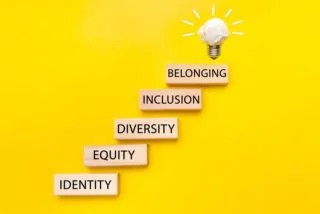Editor’s note: Top-down initiatives can set the tone for how employees experience diversity and belonging, especially in distributed workforces. Successful leaders often cultivate inclusivity through digital workplace experiences.

While remote work offers an opportunity to make the workplace more diverse, equitable and inclusive, there are also significant hurdles to overcome to ensure no one is left behind. getty
Futurist Chris Herd recently tweeted “Remote work should be the best DEI initiative in history. Single parents, people caring for others, health conditions or impairments = office impossible. Everyone should be able to access the best opportunity + it not relying on access to office.”
True, in theory. While remote work offers an opportunity to make the workplace more diverse, equitable and inclusive, there are also significant hurdles to overcome to ensure no one is left behind.
How Can Remote Work Improve DEI?
Being remote can expand what it means to be professional, making the workplace a more comfortable environment for people with significant non-work responsibilities and those who feel they need to perform the hard emotional labor of “code switching,” or changing to fit in with their colleagues.
No surprise, then, that in a study of 10,000 workers, the Future Forum from Slack found a preference for remote work is highest among underrepresented groups:
- 97% of Black knowledge workers in the U.S. prefer to work remotely or hybrid, compared to 79% of white workers.
- Black employees who work remotely feel a greater sense of belonging at work, as well as an increased ability to manage stress.
- 57% of working mothers prefer to work remotely full-time, compared with 48% of fathers.
Additionally, when companies go all-in on remote work, they can theoretically hire workers from anywhere, extending opportunity to more people. Lower-income individuals, for instance, can access good jobs without having to move to an area with a high cost of living.
Big DEI Opportunities, Big Challenges
Creating an equitable workplace culture that’s inclusive of all team members is the biggest challenge for DEI initiatives, regardless of whether an organization is remote.
Most employees, like most Americans, live in districts and neighborhoods that are racially, ethnically and economically homogenous, despite increasing diversity across the U.S. The presence of diversity without substantive, diverse interactions leaves many employees under-skilled in the cultural competency needed to form an inclusive sense of team unity, to have difficult discussions, make decisions together and evaluate each other without bias.
In the office, employees have opportunities to interact with a broader group of employees, including those outside their teams or with a different identity or perspective. Those opportunities are harder to come by in the remote setting, where we can essentially curate our interactions, limiting them to only the people we want to engage with.
The virtual space also makes it more difficult for people to engage honestly and transparently—an essential aspect of DEI training.
Working Toward An Equitable Remote Workplace
You’ll need to take some deliberate steps to ensure your remote workplace advances rather than hinders DEI initiatives. The DEI expert at my company, Centric Consulting, recommends the following actions:
Invest in DEI learning—and make it mandatory for all leaders and managers. DEI learning cannot be an opt-in activity for individuals who are charged with leading a company, managing teams or supervising others. Everyone has room for improvement, but for people in positions of leadership, competencies such as recognizing and addressing bias in the workplace are essential.
Leaders must be proficient in the cultural and social competencies necessary for driving the workplace culture toward inclusion and equity. These expectations must be baked into how you evaluate performance and define success in management roles, as well. DEI must go far beyond checking a box—it has to be an investment in a culture of lifelong learning and accountability.
DEI learning can be difficult in a virtual environment, so some experimentation will be necessary. You could invest in micro-learning, where employees complete short modules on their cellphones. Or you could go to the other end of the spectrum, where the entire organization takes a full day for a DEI teach-in.
It’s going to take a lot of trying, failing and trying again to find the solution that’s going to work for your culture.
Develop structured employee growth and support programs. Give employees equal and consistent opportunities for growth by building structured programs around coaching, mentoring, sponsorship and recognition of excellence.
In the absence of accessible career pathways, employee growth is dependent on personal networks and relationships. Development programs help people know how they are doing, envision a path to where they want to go, and receive consistent feedback and support for getting there.
Develop leaders on recognizing and addressing proximity bias. If your workplace adopts a hybrid structure, proximity bias—preferential treatment to those who choose to come more frequently into the office—could pose a major deterrent to DEI goals.
As the research referenced above indicates, some groups, including women and racial and ethnic minorities, may prefer to work remotely for a variety of reasons. If proximity bias goes unchecked, those groups will miss out on promotions, pay raises, networking opportunities and other avenues of advancement.
A good first step? Basing performance metrics strictly on results achieved.
Help team members form deep relationships with one another. Vulnerability and trust, essential in DEI work, only occur in deep, authentic relationships. To facilitate these relationships among your employees, proactively create opportunities to help people form connections with one another.
At Centric, we spend the first 10 minutes of each meeting connecting as humans. This has become part of our culture, and in my experience makes everyone more comfortable sharing pieces of their lives.
This type of personal sharing can be a challenge for underrepresented groups. Built In’s 2022 State of DEI in Tech report found that a third of BIPOC employees and 26% of women feel they cannot be their most authentic selves at work. By creating a consistent space to share with one another, and by having leaders model the behavior, these groups eventually feel comfortable opening up.
Theoretically, freeing workers from full-time office life can boost DEI efforts, making participation in the workplace a more accessible, comfortable experience for more people. But only if leaders take deliberate steps to retool some of their DEI practices to better suit an office optional workplace.
This article was written by Larry English from Forbes and was legally licensed through the Industry Dive Content Marketplace. Please direct all licensing questions to legal@industrydive.com.
GET SIMPPLR
Connect with Simpplr
Dont forget to share this blog!














